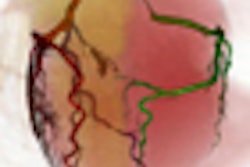Most research studies on the use of computer-aided detection (CAD) software for digital x-ray have focused on the detection of lung nodules. But new research indicates that CAD could also be useful for detecting vertebral fractures -- potentially an early sign of osteoporosis.
A group from the University of Chicago examined CAD's performance in the simultaneous detection of both lung nodules and vertebral fractures in a study published in the July 2008 issue of the American Journal of Roentgenology (Vol. 191:1, pp. 260-265). The research group was headed by Satoshi Kasai, Ph.D., with CAD pioneer Kunio Doi, Ph.D., appearing as senior author on the paper.
The authors attempted to answer multiple questions with the study. First, they wanted to see if CAD could help radiologists detect signs of vertebral fractures on lateral chest x-rays. Second, they wanted to assess the performance of CAD for lung nodules on lateral chest exams, rather than the posteroanterior views typically used for lung nodule CAD analysis. Finally, they wanted their study to parallel what they felt would be the future diagnostic paradigm in which multiple CAD algorithms would be used to detect different pathologies.
"In the future, computerized methods for detection of several diseases on chest images will be developed, and it is likely that radiologists will use a package of various CAD schemes," they wrote.
Signs of osteoporosis
The thoracic and lumbar vertebrae are the most common areas for fractures related to osteoporosis, the authors noted, and the presence of a vertebral fracture indicates a fivefold increased risk of subsequent fractures occurring.
But radiologists don't typically look for signs of vertebral fractures on chest x-rays because the studies are usually ordered for pathologies other than fractures, such as cardiovascular and pulmonary diseases, according to Kasai and colleagues. As such, radiologists looking for lung nodules might overlook the presence of vertebral fractures. Only 15% to 60% of vertebral fractures detected on lateral chest exams are mentioned in radiology reports, they wrote.
The group's CAD algorithm used a multiple-threshold technique to analyze upper and lower vertebral edges within chest images, followed by feature analysis that covered values such as vertebral height and distance from vertebra centerline to edge. The algorithm detected vertebral fractures by comparing measured vertebral height with the expected height. Following the vertebral fracture analysis, the CAD algorithm also performed analysis on lung nodules in both lateral and posteroanterior views.
To test whether CAD helped radiologists detect vertebral fractures and lung nodules, the group applied the technique to cases drawn from two databases of images, one for vertebral fractures and the other for lung nodules. The vertebral fracture database consisted of 1,000 upright chest computed radiography cases acquired from January 2005 to May 2005, while the lung nodule database consisted of 426 cases acquired from January 1999 to July 2004.
For vertebral fractures, the group decided to focus on patients with severe (grade 3) fractures and ended up with 21 fracture cases from the database. For lung nodules, 31 cases were selected, with a mean nodule size of 19.7 mm (range 8.3-29.6 mm) on the posteroanterior views and 21.6 mm (12.9-29.8 mm) on the lateral views. An additional 10 control cases with no pathology were also included.
To review the images, the researchers picked a group of 18 radiologists, six of whom were chest specialists, while the other 12 were general radiologists. They conducted their first reads without CAD assistance, rating their level of confidence in whether the images contained a fracture or a lung nodule smaller than 30 mm, as well as the most likely location of pathology. The second reading was conducted with CAD, and the radiologists were asked to note whether their confidence level had changed.
In analyzing the results, Kasai and colleagues found that CAD resulted in a statistically significant improvement in radiologist performance for detecting vertebral fractures. As measured by the area under the receiver operating characteristic curve (AUC), radiologists assessing vertebral fractures saw their performance go from 0.906 before CAD to 0.951 (p = 0.002) with CAD. The improvement was less pronounced (and was not statistically significant) for lung nodules: the radiologists' AUC scores went from 0.804 to 0.816 (p = 0.297).
The researchers found that CAD had a particularly beneficial effect in helping radiologists find vertebral fractures below the diaphragm and in the upper lung area. For example, in the six cases with fractures below the diaphragm, four were missed by the radiologists without CAD but were detected with CAD assistance. In addition, six radiologists missed a severe vertebral fracture in the upper lung area, but all were able to detect it with CAD.
In terms of assessing CAD's performance for lung nodules in lateral chest radiographs, the authors speculated that the lack of statistical significance could be related to the selection of subtle lung lesions from the database.
By Brian Casey
AuntMinnie.com staff writer
July 7, 2008
Related Reading
CAD helps residents identify lung nodules on DR, May 20, 2008
Criteria determine CAD mark sensitivity, March 20, 2008
CAD provides mixed benefits for DR lung exams, March 8, 2008
DR image processing produces mixed CAD results, February 12, 2008
Chest x-ray lung CAD reimbursement picks up, October 24, 2006
Copyright © 2008 AuntMinnie.com



















